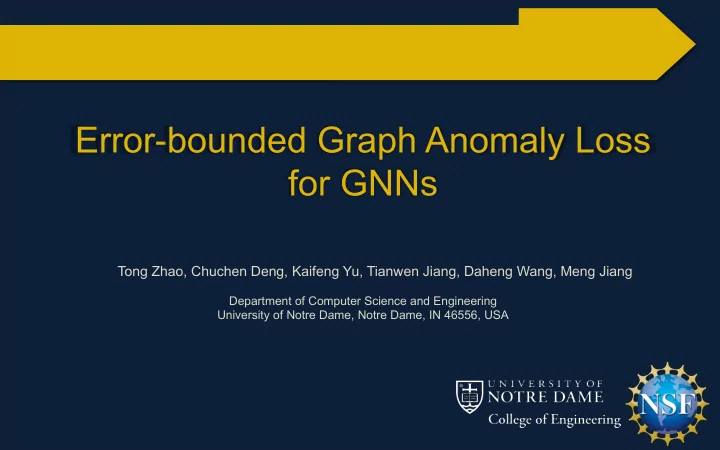

Error-bounded Graph Anomaly Loss for GNNs Tong Zhao, Chuchen Deng, Kaifeng Yu, Tianwen Jiang, Daheng Wang, Meng Jiang Department of Computer Science and Engineering University of Notre Dame, Notre Dame, IN 46556, USA
Graph Outliers. – Fake/unfair reviewers on reviewing networks, etc. Dense Blocks. – Spammers/bot nets on social networks, etc. 1 Tong Zhao
Unsupervised graph mining methods: – Graph outlier detection: • Feature-based • Structure-based • Model-based – Dense block detection: • Average degree • Singular value Graph neural networks (GNNs) with unsupervised loss function for representation learning. 2 Tong Zhao
Basic assumption: – Nodes that are closer to each other in the graph should have similar representations. With positive/negative sampling, can be formulated as: 3 Tong Zhao
Basic assumption: – Nodes that are closer to each other in the graph should have similar representations. With positive/negative sampling, can be formulated as: Problem: – The assumption doesn’t always hold true when the representations are used for anomaly detection. 4 Tong Zhao
Goal: design an unsupervised loss function that can learn node representations that are optimized for anomaly detection. Desired abilities: – Give anomalous nodes similar representations. – Utilize the global information given by graph mining methods. – Capable of dealing with severely imbalanced data. 5 Tong Zhao
Goal: design an unsupervised loss function that can learn node representations that are optimized for anomaly detection. Desired abilities: – Give anomalous nodes similar representations. – Utilize the global information given by graph mining methods. – Capable of dealing with severely imbalanced data. 6 Tong Zhao
Existing outlier detection methods can give us: – 𝒱 ! : set of normal nodes; 𝒱 " : set of outlier nodes: Goals: – Encourage pairs of outlier nodes to have similar representations. – Encourage pairs of normal nodes to have similar representations. – Enforce the representations of pairs of outlier and normal nodes are distinct. 7 Tong Zhao
Existing dense block detection methods can give us: – 𝒱 # : set of normal nodes; – Sets of nodes in different dense blocks: 𝒱 $,& , 𝒱 $,' , … Goals: – Encourage node pairs in the same block to have similar representations. – Enforce nodes in different blocks to have distinct representations. 8 Tong Zhao
9 Tong Zhao
Thanks for listening! Funded by National Science Foundation IIS-1849816.
Recommend
More recommend